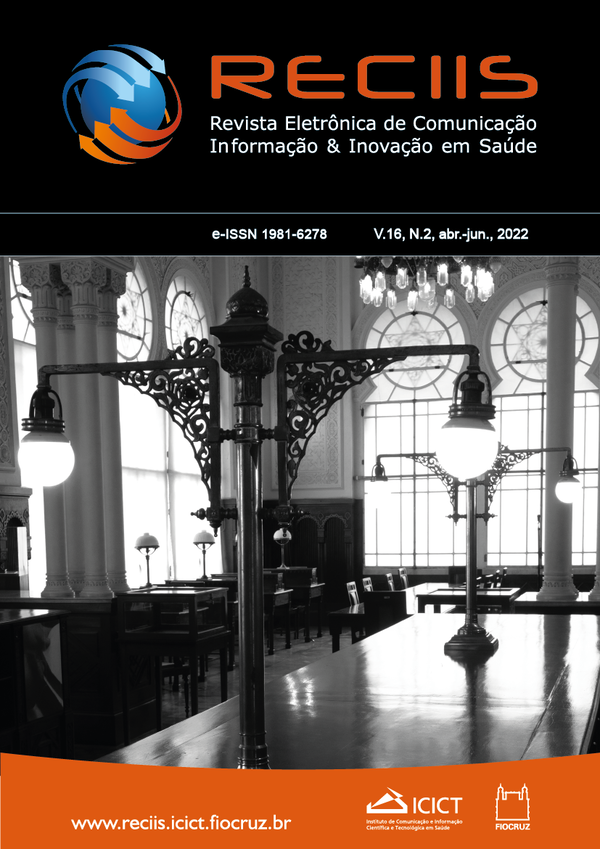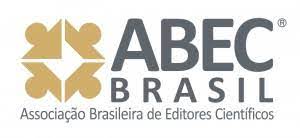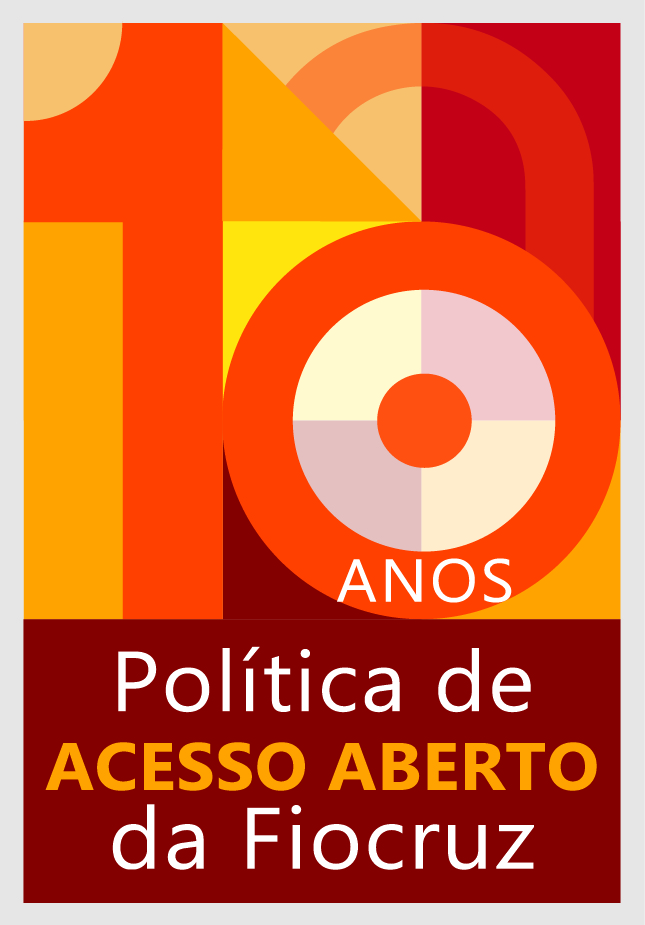Uso da tecnologia no ensino em saúde – perspectivas e aplicabilidades
DOI :
https://doi.org/10.29397/reciis.v16i2.2439Mots-clés :
Tecnologia da Informação e Comunicação, Formação em saúde, Ensino médico, Educação à distância, Covid-19.Résumé
As Tecnologias da Informação e Comunicação (TIC), inseridas também na saúde, podem promover ganho substancial ao ensino da área, fornecendo recursos didáticos adicionais, relevantes aos docentes, principalmente em períodos de pandemia, quando várias instituições necessitarão desenvolver meios tecnológicos emergenciais para a aprendizagem (Emergency Remote Teaching – ERT). O artigo, através de revisão narrativa, objetiva rever o uso das tecnologias na saúde e no ensino médico, bem como discutir sobre as perspectivas existentes no mundo pós-pandemia. Nesse conceito, o ensino on-line assume importância estratégica, permitindo uma modalidade educacional flexível, aberta e interativa, favorecendo o ensino colaborativo, não esquecendo alguns contrapontos, tais como a disponibilidade do acesso e a sobrecarga cognitiva (“fadiga zoom”). A crise pandêmica atual trouxe, além da adoção de tecnologias, a possibilidade de modernizar o ensino como um todo, melhorando a eficiência e tornando a experiência acadêmica mais reflexiva, através de um ensino híbrido, presencial e virtual.
Références
ALMARZOOQ, Zaid I.; LOPES, Mathew; KOCHAR, Ajar. Virtual learning during the covid-19 pandemic: a disruptive technology in graduate medical education. Journal of the American College of Cardiology, Nova York, v. 75, n. 20, p. 2635-2638, 2020. DOI: https://doi.org/10.1016/j.jacc.2020.04.015. Disponível em: https://linkinghub.elsevier.com/retrieve/pii/S0735109720349172. Acesso em: 20 abr. 2022.
ALMEIDA, Marcio José de. Tecnologia e medicina: uma visão da academia. Revista Bioética, Brasília, DF, v. 8, n. 1, p. 69-78, 2009. Disponível em: https://revistabioetica.cfm.org.br/index.php/revista_bioetica/article/view/262. Acesso em: 18 abr. 2022.
ANTUNES, João Lobo. Medicina e tecnologia. Janus Online, Lisboa, 2009. Disponível em: http://www.janusonline.pt/arquivo/2009/2009_2_21.html. Acesso em: 30 jun. 2021.
BANOVAC, Ivan et al. The anatomy lesson of the SARS-CoV-2 pandemic: irreplaceable tradition (cadaver work) and new didactics of digital technology. Croatian Medical Journal, v. 62, n. 2, p. 173-186, 2021. DOI: https://dx.doi.org/10.3325%2Fcmj.2021.62.173. Disponível em: https://www.ncbi.nlm.nih.gov/pmc/articles/PMC8107989/. Acesso em: 18 ab. 2022.
BILAL, Saira; SHANMUGAM, Victoria K. Enhancing rheumatology education during the covid-19 pandemic. Rheumatology International, Berlin, v. 41, n. 3, p. 1-6, 2021. DOI: https://doi.org/10.1007/s00296-020-04769-0. Disponível em: https://link.springer.com/article/10.1007/s00296-020-04769-0. Acesso em: 20 abr. 2022.
BOKOLO, Anthony Jnr. Exploring the adoption of telemedicine and virtual software for care of outpatients during and after covid-19 pandemic. Irish Journal of Medical Science, Dublin, v. 190, n. 1, p. 1-10, 2021. DOI: https://doi.org/10.1007/s11845-020-02299-z. Disponível em: https://link.springer.com/article/10.1007/s11845-020-02299-z. Acesso em: 19 abr. 2022.
BOLLELA, Valdes Roberto et al. Aprendizagem baseada em equipes: da teoria à prática. Medicina (Ribeirão Preto), Ribeirão Preto, v. 47, n. 3, p. 293-300, 2014. DOI: https://doi.org/10.11606/issn.2176-7262.v47i3p293-300. Disponível em: https://www.revistas.usp.br/rmrp/article/view/86618. Acesso em: 20 abr. 2022.
BOLTON, W. S. et al. Disseminating technology in global surgery. British Journal of Surgery, Oxford, v. 106, n. 2, p. e34-e43, 2019. DOI: https://doi.org/10.1002/bjs.11036. Disponível em: https://academic.oup.com/bjs/article/106/2/e34/6120763?login=true. Acesso em: 19 abr. 2022.
BRIZ-PONCE, Laura et al. Effects of mobile learning in medical education: a counterfactual evaluation. Journal of Medical Systems, Nova York, v. 40, n. 6, p. 136, 2016. DOI: https://doi.org/10.1007/s10916-016-0487-4. Disponível em: https://link.springer.com/article/10.1007/s10916-016-0487-4. Acesso em: 20 abr. 2022.
CAIRNEY-HILL, Jess et al. Challenges and opportunities for undergraduate clinical teaching during and beyond the covid-19 pandemic. Journal of the Royal Society of Medicine, Londres, v. 114, n. 3, p. 113-116, 2021. DOI: https://doi.org/10.1177/0141076820980714. Disponível em: https://journals.sagepub.com/doi/10.1177/0141076820980714. Acesso em: 20 abr. 2022.
CAPECCI, Marianna et al. Clinical effects of robot-assisted gait training and treadmill training for Parkinson’s disease: a randomized controlled trial. Annals of Physical and Rehabilitation Medicine, Amsterdã, v. 62, n. 5, p. 303-312, 2019. DOI: https://doi.org/10.1016/j.rehab.2019.06.016. Disponível em: https://www.sciencedirect.com/science/article/pii/S1877065719301071?via%3Dihub. Acesso em: 19 abr. 2022.
CASÀ, Calogero et al. Covid-19 and digital competencies among young physicians: are we (really) ready for the new era? A national survey of the Italian Young Medical Doctors Association. Annali dell’Istituto Superiore di Sanità, Roma, v. 57, n.1, p. 1-6, 2021. DOI: https://doi.org/10.4415/ann_21_01_01. Disponível em: https://www.iss.it/documents/20126/0/ANN_21_01_01.pdf. Acesso em: 18 abr. 2022.
CAVALCANTE, Ana Suelen Pedroza et al. Educação superior em saúde: a educação a distância em meio à crise do novo coronavírus no Brasil. Avances en Enfermería, Bogotá, v. 38, n. suppl. 1, p. 52-60, 2020. DOI: https://doi.org/10.15446/av.enferm.v38n1supl.86229. Disponível em: https://revistas.unal.edu.co/index.php/avenferm/article/view/86229. Acesso em: 19 abr. 2022.
CENTRO REGIONAL DE ESTUDOS PARA O DESENVOLVIMENTO DA SOCIEDADE DA INFORMAÇÃO DO BRASIL (CETIC). TIC Domicílios 2019. São Paulo: Cetic, 2019. Disponível em: https://cetic.br/pt/tics/domicilios/2019/domicilios/A4B/. Acesso em: 10 jul. 2021.
CENTRO REGIONAL DE ESTUDOS PARA O DESENVOLVIMENTO DA SOCIEDADE DA INFORMAÇÃO DO BRASIL (CETIC). TIC Governo Eletrônico 2015: órgãos públicos federais e estaduais. São Paulo: Cetic, 2015. Disponível em: https://cetic.br/publicacao/pesquisa-sobre-o-uso-das-tecnologias-de-informacao-e-comunicacao-nos-domicilios-brasileiros-tic-domicilios-2015/. Acesso em: 08 mar. 2021.
CHEN, Cathy Hsi; MULLEN, Alexander Joseph. Covid-19 can catalyze the modernization of medical education. JMIR Medical Education, Toronto, v. 6, n. 1, p. e19725, 2020. DOI: https://doi.org/10.2196/19725. Disponível em: https://mededu.jmir.org/2020/1/e19725/. Acesso em: 19 abr. 2022.
CODE, Jilliane; RALPH, Rachel; FORDE, Kieran. Pandemic designs for the future: perspectives of technology education teachers during covid-19. Information and Learning Sciences, Londres, v. 121, n. 5/6, p. 419-431, 2020. DOI: http://dx.doi.org/10.1108/ILS-04-2020-0112. Disponível em: https://www.emerald.com/insight/content/doi/10.1108/ILS-04-2020-0112/full/html. Acesso em: 20 abr. 2022.
COSTA, Inês Teresa Lyra Gaspar da. Metodologia do ensino a distância. Salvador: UFBA, 2016.
CUNHA, Ana Luiza Garcia; TERRERI, Maria Teresa; LEN, Claudio Arnaldo. Ambiente virtual de aprendizagem em reumatologia pediátrica para residentes em pediatria. Revista Paulista de Pediatria, São Paulo, v. 38, p. 1-8, 2020. DOI: https://doi.org/10.1590/1984-0462/2020/38/2018189. Disponível em: https://www.scielo.br/j/rpp/a/56KDC63D6yfGSW5c6FrWbJm/abstract/?lang=pt. Acesso em: 20 abr. 2022.
DEDEILIA, Aikaterini et al. Medical and surgical education challenges and innovations in the covid-19 era: a systematic review. In Vivo, Atenas, v. 34, n. suppl. 3, p. 1603-1611, 2020. DOI: https://doi.org/10.21873/invivo.11950. Disponível em: https://iv.iiarjournals.org/content/34/3_suppl/1603. Acesso em: 18 abr. 2022.
DEWSBURY, Guy. Use of information and communication technology in nursing services. British Journal of Community Nursing, Londres, v. 24, n. 12, p. 604-607, 2019. DOI: https://doi.org/10.12968/bjcn.2019.24.12.604. Disponível em: https://www.magonlinelibrary.com/doi/abs/10.12968/bjcn.2019.24.12.604. Acesso em: 19 abr. 2022.
DUA, Anisha B. et al. Challenges, collaboration, and innovation in rheumatology education during the covid-19 pandemic: leveraging new ways to teach. Clinical Rheumatology, Bruxelas, v. 39, n. 12, p. 3535-3541, 2020. DOI: https://doi.org/10.1007/s10067-020-05449-x. Disponível em: https://link.springer.com/article/10.1007/s10067-020-05449-x. Acesso em: 20 abr. 2022.
DUNN, William F. et al. Systems integration. In: LEVINE, Adam I. et al. (ed.). The comprehensive textbook of healthcare simulation. New York: Springer, 2013. p. 95-110. E-book. DOI: http://dx.doi.org/10.1007/978-1-4614-5993-4_10. Disponível em: https://link.springer.com/chapter/10.1007/978-1-4614-5993-4_10. Acesso em: 20 abr. 2022.
FARIAS, Queila Samara dos Santos et al. Gamificação no ensino de enfermagem: avaliação do impacto na aprendizagem. Research, Society and Development, Itajubá, v. 10, n. 16, p. e591101623884, 2021. DOI: http://dx.doi.org/10.33448/rsd-v10i16.23884. Disponível em: https://rsdjournal.org/index.php/rsd/article/view/23884. Acesso em: 20 abr. 2022.
FIDA, Mariam; KASSAB, Salah Eldin. Do medical students’ scores using different assessment instruments predict their scores in clinical reasoning using a computer-based simulation?. Advances in Medical Education and Practice, Auckland, v. 20, n. 6, p. 135-141, 2015. DOI: https://doi.org/10.2147/amep.s77459. Disponível em: https://www.dovepress.com/do-medical-studentsrsquo-scores-using-different-assessment-instruments-peer-reviewed-fulltext-article-AMEP. Acesso em: 20 abr. 2022.
GABER, Dalia A.; SHEHATA, Mohamed Hany; AMIN, Hebat Allah. Online team-based learning sessions as interactive methodologies during the pandemic. Medical Education, Oxford, 54, n. 7, p. 666-667, 2020. DOI: https://doi.org/10.1111/medu.14198. Disponível em: https://onlinelibrary.wiley.com/doi/10.1111/medu.14198. Acesso em: 20 abr. 2022.
GERMANI, Ana Claudia Camargo Gonçalves et al. O uso de tecnologias de informação e comunicação (TIC) em experiências de pós-graduação sobre promoção da saúde no Brasil e na Costa Rica. Revista de Medicina, São Paulo, v. 92, n. 2, p. 97-103, 2013. DOI: https://doi.org/10.11606/issn.1679-9836.v92i2p97-103. Disponível em: https://www.revistas.usp.br/revistadc/article/view/79954. Acesso em: 19 abr. 2022.
HANJANI, Leila Shafiee et al. A scoping review of the use and impact of telehealth medication reviews. Research in Social and Administrative Pharmacy, Nova York, 16, n. 8, p. 1140-1153, ago. 2020. DOI: https://doi.org/10.1016/j.sapharm.2019.12.014. Disponível em: https://www.sciencedirect.com/science/article/pii/S1551741119306485?via%3Dihub. Acesso em: 19 abr. 2022.
HARENDZA, Sigrid et al. Evaluation of a telemedicine-based training for final-year medical students including simulated patient consultations, documentation, and case presentation. GMS Journal for Medical Education, Erlangen, v. 37, n. 7, p. Doc94, 2020. DOI: https://doi.org/10.3205/zma001387. Disponível em: https://www.egms.de/static/en/journals/zma/2020-37/zma001387.shtml. Acesso em: 20 abr. 2022.
HODGES, Charles et al. The difference between emergency remote teaching and online learning. EDUCAUSE Review, Boulder, 27 mar. 2020. Articles. Disponível em: https://er.educause.edu/articles/2020/3/the-difference-between-emergency-remote-teaching-and-online-learning. Acesso em: 18 abr. 2022.
HRASTINSKI, Stefan. What do we mean by blended learning?. TechTrends, Bloomington, v. 63, n. 5, p. 564-569, 2019. DOI: https://doi.org/10.1007/s11528-019-00375-5. Disponível em: https://link.springer.com/article/10.1007/s11528-019-00375-5. Acesso em: 19 abr. 2022.
ISMAIL, Muhd Al-Aarifin et al. Using Kahoot! as a formative assessment tool in medical education: a phenomenological study. BMC Medical Education, Londres, 19, n. 1, p. 230, jun. 2019. DOI: https://doi.org/10.1186/s12909-019-1658-z. Disponível em: https://bmcmededuc.biomedcentral.com/articles/10.1186/s12909-019-1658-z. Acesso em: 20 abr. 2022.
JACK, Megan M. et al. Live-streaming surgery for medical student education – educational solutions in neurosurgery during the covid-19 pandemic. Journal of Surgical Education, Nova York, v. 78, n. 1, p. 99-103, 2021. DOI: https://doi.org/10.1016/j.jsurg.2020.07.005. Disponível em: https://linkinghub.elsevier.com/retrieve/pii/S1931720420302397. Acesso em: 20 abr. 2022.
KOHN, Linda T.; CORRIGAN, Janet M.; DONALDSON, Molla S. (ed.) To err is human: building a safer health system. Washington (D.C.): National Academy Press, 2000. E-book. Disponível em: https://portaldeboaspraticas.iff.fiocruz.br/biblioteca/to-err-is-human-building-a-safer-health-system/. Acesso em: 8 maio 2021.
KOUMPOURAS, Fotios; HELFGOTT, Simon. Stand together and deliver: challenges and opportunities for rheumatology education during the covid-19 pandemic. Arthritis & Rheumatology, Malden, v. 72, n. 7, p. 1064-1066, 2020. DOI: https://doi.org/10.1002/art.41278. Disponível em: https://onlinelibrary.wiley.com/doi/10.1002/art.41278. Acesso em: 19 abr. 2022.
KUBRUSLY, Marcos et al. Percepção docente sobre a Aprendizagem Baseada em Problemas no ensino remoto durante a pandemia covid-19. Research, Society and Development, Itajubá, v. 10, n. 5, p. e53510515280, 2021. DOI: https://doi.org/10.33448/rsd-v10i5.15280. Disponível em: https://rsdjournal.org/index.php/rsd/article/view/15280. Acesso em: 19 abr. 2022.
KYAW, Bhone Myint et al. Effectiveness of digital education on communication skills among medical students: systematic review and meta-analysis by the digital health education collaboration. Journal of Medical Internet Research, Toronto, v. 21, n. 8, p. e12967, 2019. DOI: https://doi.org/10.2196/12967. Disponível em: https://www.jmir.org/2019/8/e12967/. Acesso em: 25 abr. 2022.
LENES, Andrea et al. Crisis as a chance: a digital training of social competencies with simulated persons at the Medical Faculty of RWTH Aachen, due to the lack of attendance teaching in the SARS-CoV-2 pandemic. GMS Journal for Medical Education, Erlangen, v. 37, n. 7, p. Doc82, 2020. DOI: https://doi.org/10.3205/zma001375. Disponível em: https://www.egms.de/static/en/journals/zma/2020-37/zma001375.shtml. Acesso em: 20 abr. 2022.
LORENZETTI, Jorge et al. Tecnologia, inovação tecnológica e saúde: uma reflexão necessária. Texto & Contexto – Enfermagem, Florianópolis, v. 21, n. 2, p. 432-439, 2012. DOI: https://doi.org/10.1590/S0104-07072012000200023. Disponível em: https://www.scielo.br/j/tce/a/63hZ64xJVrMf5fwsBh7dnnq/?lang=pt. Acesso em: 18 abr. 2022.
MACHADO, Lucas Dias Soares et al. Representações de profissionais residentes acerca das estratégias pedagógicas utilizadas no processo formativo da residência multiprofissional. Revista da Escola de Enfermagem da USP, São Paulo, v. 52, p. 1-8, 2018. DOI: https://doi.org/10.1590/S1980-220X2017024803386. Disponível em: https://www.scielo.br/j/reeusp/a/7sztMRNmzC4nPZnRV7tCbHn/?format=pdf&lang=pt. Acesso em: 25 abr. 2022.
MALDONADO, Jose Manuel Santos de Varge; MARQUES, Alexandre Barbosa; CRUZ, Antonio. Telemedicina: desafios à sua difusão no Brasil. Cadernos de Saúde Pública, Rio de Janeiro, v. 32, n. suppl 2, p. e00155615, 2016. DOI: https://doi.org/10.1590/0102-311X00155615. Disponível em: https://www.scielo.br/j/csp/a/54bg8d5mfWmCC9w7M4FKFVq/?lang=pt. Acesso em: 19 abr. 2022.
MALLON, Daniel et al. Impact of covid-19 on pediatric gastroenterology fellow training in North America. Journal of Pediatric Gastroenterology and Nutrition, Nova York, v. 71, n. 1, p. 6-11, 2020. DOI: https://doi.org/10.1097/mpg.0000000000002768. Disponível em: https://journals.lww.com/jpgn/Fulltext/2020/07000/Impact_of_COVID_19_on_Pediatric_Gastroenterology.5.aspx. Acesso em: 19 abr. 2022.
MARTINS, Viviane Lima. Tecnologia de Informação e Comunicação (TIC) e Educação. Revista Intraciência, Guarujá, v. 13, n. 1, p. 1-11, 2017. Disponível em: http://uniesp.edu.br/sites/_biblioteca/revistas/20170710083906.pdf. Acesso em: 18 abr. 2022.
MENG, Qiaoling et al. Pilot Study of a Powered Exoskeleton for Upper Limb Rehabilitation Based on the Wheelchair. BioMed Research International, Nova York, v. 2019, p. 1-12, 2019. Artigo 9627438. DOI: https://doi.org/10.1155/2019/9627438. Disponível em: https://www.hindawi.com/journals/bmri/2019/9627438/. Acesso em: 19 abr. 2022.
MONTEIRO, Diully Siqueira et al. Validação de uma tecnologia educativa em biossegurança na atenção primária. Revista Cuidarte, Bucaramanga, v. 10, n. 2, p. 1-11, 2019. DOI: https://doi.org/10.15649/cuidarte.v10i2.654. Disponível em: https://revistas.udes.edu.co/cuidarte/article/view/654. Acesso em: 18 abr. 2022.
MORAN, Joshua; BRISCOE, Gregory; PEGLOW, Stephanie. Current technology in advancing medical education: perspectives for learning and providing care. Academic Psychiatry, Washington, D.C., v. 42, n. 6, p. 796-799, 2018. DOI: https://doi.org/10.1007/s40596-018-0946-y. Disponível em: https://link.springer.com/article/10.1007/s40596-018-0946-y. Acesso em: 20 abr. 2022.
QUEIROZ, Ana Carolina Muller et al. Tradução, validação e aplicação da Escala ZEF (ZEF Scale) para avaliação da fadiga Zoom na população brasileira (Translation, validation and application of the ZEF Scale to assess Zoom fatigue in the Brazilian population). SSRN, [s. l.], p. 1-24, 2021. Disponível em: https://papers.ssrn.com/sol3/papers.cfm?abstract_id=3844219. Acesso em: 19 abr. 2022.
OH, Hans et al. What is eHealth?: a systematic review of published definitions. World Hospitals and Health Services, Londres, v. 41, n. 1, p. 32-40, 2005. Disponível em: https://www.researchgate.net/profile/Murray-Enkin-2/publication/7858958_What_is_eHealth_A_systematic_review_of_published_definitions/links/00b7d5378219111f52000000/What-is-eHealth-A-systematic-review-of-published-definitions.pdf. Acesso em: 20 abr. 2022.
OLIVEIRA, Cláudio de; MOURA, Samuel Pedrosa; SOUSA, Edinaldo Ribeiro. TIC’S na educação: a utilização das Tecnologias da Informação e Comunicação na aprendizagem do aluno. Pedagogia em Ação, Belo Horizonte, v. 7, n. 1, p. 75-95, 2015. Disponível em: http://periodicos.pucminas.br/index.php/pedagogiacao/article/view/11019. Acesso em: 18 abr. 2022.
PATRU, Mariana (coord). Information and communication technologies in schools: a handbook for teachers or how ICT can create new, open learning environments. Paris: Unesco, 2005. Disponível em: http://unesdoc.unesco.org/images/0013/001390/139028e.pdf. . Acesso em: 04 ago. 2021.
PEARS, Matthew et al. Role of immersive technologies in healthcare education during the covid-19 epidemic. Scottish Medical Journal, Edinburgo, v. 65, n. 4, p. 112-119, 2020. DOI: https://doi.org/10.1177/0036933020956317. Disponível em: https://journals.sagepub.com/doi/10.1177/0036933020956317. Acesso em: 19 abr. 2022.
PENHA, Joaquim Rangel Lucio da et al. Validação e utilização de novas tecnologias na saúde e educação: uma revisão integrativa. Revista Interdisciplinar de Promoção da Saúde, v. 1, n. 3, p. 199-206, 2018. DOI: https://doi.org/10.17058/rips.v1i3.12580. Disponível em: https://online.unisc.br/seer/index.php/ripsunisc/article/view/12580. Acesso em: 19 abr. 2022.
POULTON, Terry. et al. Exploring the efficacy of replacing linear paper-based patient cases in problem-based learning with dynamic Web-based virtual patients: randomized controlled trial. Journal of Medical Internet Research, Toronto, v. 16, n. 11, p. e240, 2014. DOI: https://doi.org/10.2196/jmir.3748. Disponível em: https://www.jmir.org/2014/11/e240/. Acesso em: 20 abr. 2022.
PRENSKY, Mark. Digital natives, digital immigrants. On the Horizon, Bradford, v. 9, n. 5, p. 1-6, 2001. Disponível em: https://www.marcprensky.com/writing/Prensky%20-%20Digital%20Natives,%20Digital%20Immigrants%20-%20Part1.pdf. Acesso em: 18 abr. 2022.
RAHIM, Ahmad Fuad Abdul. Guidelines for online assessment in emergency remote teaching during the covid-19 pandemic. Education in Medicine Journal, Pinang, v. 12, n. 2, 2020. DOI: https://doi.org/10.21315/eimj2020.12.2.6. Disponível em: https://eduimed.usm.my/EIMJ20201202/EIMJ20201202_06.pdf. Acesso em: 20 abr. 2022.
RIDDELL, Jefrrey et al. Independent and interwoven: a qualitative exploration of residents’ experiences with educational podcasts. Academic Medicine, Filadélfia, v. 95, n. 1, p. 89-96, 2020. DOI: https://doi.org/10.1097/acm.0000000000002984. Disponível em: https://journals.lww.com/academicmedicine/Fulltext/2020/01000/Independent_and_Interwoven__A_Qualitative.29.aspx. Acesso em: 20 abr. 2022.
RODRIGUES, Eva Lorena Jaques; MORI, Rejane Maria Sales Cavalcante; FIGUEIREDO, Sandra Maria dos Santos. Desenvolvimento de uma tecnologia educacional para pais e/ou cuidadores de crianças com Alergia à Proteína do Leite de Vaca (APLV). Revista Eletrônica Acervo Saúde, São Paulo, v. 13, n. 12, p. e9281-e9281, 2021. DOI: https://doi.org/10.25248/reas.e9281.2021. Disponível em: https://acervomais.com.br/index.php/saude/article/view/9281. Acesso em: 19 abr. 2022.
ROSE, Suzanne. Medical Student Education in the Time of covid-19. JAMA – Journal of the American Medical Association, Chicago, v. 323, n. 21, p. 2131-2132, 2020. DOI: https://doi.org/10.1001/jama.2020.5227. Disponível em: https://jamanetwork.com/journals/jama/fullarticle/2764138. Acesso em: 20 abr. 2022.
ROTH, Julie et al. Why not a podcast? assessing narrative audio and written curricula in obstetrical neurology. Journal of Graduate Medical Education, Chicago, v. 12, n. 1, p. 86-91, 2020. DOI: https://doi.org/10.4300/jgme-d-19-00505.1. Disponível em: https://meridian.allenpress.com/jgme/article/12/1/86/428736/Why-Not-a-Podcast-Assessing-Narrative-Audio-and. Acesso em: 20 abr. 2022.
SALES, Odete Máyra Mesquita; PINTO, Virginia Bentes. Tecnologias digitais de informação para a saúde: revisando os padrões de metadados com foco na interoperabilidade. Revista Eletrônica de Comunicação, Informação e Inovação em Saúde, Rio de Janeiro, v. 13, n. 1, p. 208-211, 2019. DOI: https://doi.org/10.29397/reciis.v13i1.1469. Disponível em: https://www.reciis.icict.fiocruz.br/index.php/reciis/article/view/1469. Acesso em: 18 abr. 2022.
SEYMOUR-WALSH, Amy E.; WEBER, Anthony, BELL, A. Pedagogical foundations to online lectures in health professions education. Rural and Remote Health, Townsville, v. 20, n. 2, p. 6038, 2020. DOI: https://doi.org/10.22605/rrh6038. Disponível em: https://www.rrh.org.au/journal/article/6038. Acesso em: 13 abr. 2021.
SHACKLETON, Claire et al. Effectiveness of over-ground robotic locomotor training in improving walking performance, cardiovascular demands, secondary complications and user-satisfaction in individuals with spinal cord injuries: a systematic review. Journal of Rehabilitation Medicine, Estocolmo, v. 51, n. 10, p. 723-733, 2019. DOI: https://doi.org/10.2340/16501977-2601. Disponível em: https://www.medicaljournals.se/jrm/content/abstract/10.2340/16501977-2601. Acesso em: 19 abr. 2022.
SIMÃO, José Pedro Schardosim et al. Utilização de experimentação remota móvel no ensino médio. RENOTE – Revista Novas Tecnologias na Educação, Porto Alegre, v. 11, n. 1, p. 1-11, 2013. DOI: https://doi.org/10.22456/1679-1916.41701. Disponível em: https://seer.ufrgs.br/renote/article/view/41701. Acesso em: 19 abr. 2022.
SIVARAJAH, Rebecca T. et al. A review of innovative teaching methods. Academic Radiology, Reston, v. 26, n.1, p. 101-113, 2018. DOI: https://doi.org/10.1016/j.acra.2018.03.025. Disponível em: https://www.sciencedirect.com/science/article/pii/S1076633218301387?via%3Dihub. Acesso em: 19 abr. 2022.
STARKWEATHER, Angela et al. The use of technology to support precision health in nursing science. Journal of Nursing Scholarship, Hoboken, v. 51, n. 6, p. 614-623, 2019. DOI: https://doi.org/10.1111/jnu.12518. Disponível em: https://sigmapubs.onlinelibrary.wiley.com/doi/10.1111/jnu.12518. Acesso em: 19 abr. 2022.
VALDEZ-GARCÍA, Jorge E et al. The role of the medicine student in covid-19 pandemic: a shared responsibility. Cirugía y Cirujanos, Cidade do México, v. 88, n. 4, p. 399-401, 2020. DOI: https://doi.org/10.24875/ciru.m20000066. Disponível em: http://www.cirugiaycirujanos.com/frame_esp.php?id=289. Acesso em: 20 abr. 2022.
VENUTURUPALLI, R. Swamy; SUFKA, Paul; BHANA, Suleman. Digital medicine in rheumatology: challenges and opportunities. Rheumatic Disease Clinics of North America, Filadélfia, v. 45, n. 1, p. 113-126, 2019. DOI: https://doi.org/10.1016/j.rdc.2018.09.010. Disponível em: https://www.rheumatic.theclinics.com/article/S0889-857X(18)30089-9/fulltext. Acesso em: 20 abr. 2022.
VERASZTO, Estéfano Vizconde. Projeto Teckids: educação tecnologica no ensino fundamental. 2004. 184 p. Dissertação (Mestrado em Educação, Ciência e Tecnologia) – Universidade Estadual de Campinas, Campinas, 2004. Disponível em: http://repositorio.unicamp.br/Acervo/Detalhe/315223. Acesso em: 20 abr. 2022.
YOUNG, Antony J. Novas tecnologias e Medicina de Família. Revista Brasileira de Medicina de Família e Comunidade, Rio de Janeiro, v. 12, n. 39, p. 1-6, 2017. DOI: https://doi.org/10.5712/rbmfc12(39)1465. Disponível em: https://rbmfc.org.br/rbmfc/article/view/1465. Acesso em: 19 abr. 2022.
ZHOU, Ting et al. The distance teaching practice of combined mode of massive open online course micro-video for interns in emergency department during the covid-19 epidemic period. Telemedicine Journal and e-Health, Larchmont, v. 26, n. 5, p. 584-588, 2020. DOI: https://doi.org/10.1089/tmj.2020.0079. Disponível em: https://www.liebertpub.com/doi/10.1089/tmj.2020.0079. Acesso em: 20 abr. 2022.
Téléchargements
Publiée
Comment citer
Numéro
Rubrique
Licence
Direitos de autor: O autor retém, sem restrições dos direitos sobre sua obra.
Direitos de reutilização: A Reciis adota a Licença Creative Commons, CC BY-NC atribuição não comercial conforme a Política de Acesso Aberto ao Conhecimento da Fundação Oswaldo Cruz. Com essa licença é permitido acessar, baixar (download), copiar, imprimir, compartilhar, reutilizar e distribuir os artigos, desde que para uso não comercial e com a citação da fonte, conferindo os devidos créditos de autoria e menção à Reciis. Nesses casos, nenhuma permissão é necessária por parte dos autores ou dos editores.
Direitos de depósito dos autores/autoarquivamento: Os autores são estimulados a realizarem o depósito em repositórios institucionais da versão publicada com o link do seu artigo na Reciis.












